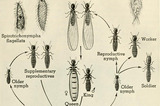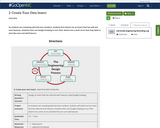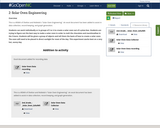
Using the robot, Dash, students will program him to land on different numbers in order to make a specific total.
- Subject:
- Mathematics
- STEM
- Material Type:
- Activity/Lab
- Author:
- Glenn Shelton
- Carrie Robledo
- Date Added:
- 03/30/2020

Using the robot, Dash, students will program him to land on different numbers in order to make a specific total.

Students will construct a zoo exhibit based on one from the book using the materials provided, complete with zoo animal.You must use ONLY the supplies provided. The zoo exhibit must be constructed on a flat surface and it must be as accurate as possible based on one from the book.

Students create an engineering project using Keva Planks based on the Folk Tale, Three Billy Goat Gruff. They have the following limitations. Only blocksSpan of river wider than the planks (span is 8 inches)Not weight bearingCan’t build on top of banks (the end of the river base/supports)15 minutes to build

In this engaging lesson titled "Wolf Watchers: Crafting an Alarm to Keep Sheep Safe!", inspired by "The Boy Who Cried Wolf" from CKLA Knowledge, students delve into the concept of creating an alarm system to protect sheep from approaching wolves. The activity centers around designing an innovative alarm system that alerts villagers when a wolf is near.

As students are reviewing odd and even numbers, students first sketch out a bug that has odd or even features. Students then use Google Drawing to turn their sketch into a work of art that they label to describe even and odd features.

As students are reviewing odd and even numbers, students first sketch out a bug that has odd or even features. Students then use Tinkercad to turn their sketch into a 3D design to be printed.

As students are reviewing odd and even numbers, students first sketch out a bug that has odd or even features. Students then use Google Drawing to turn their sketch into a work of art that they label to describe even and odd features.

As students are reviewing odd and even numbers, students first sketch out an insect that has odd and even features. Students then use Google Drawing to turn their sketch into a work of art that they label to describe even and odd features.

As students study Harriet Tubman and her contribution to the Underground Railroad, students will create a map that is labeled with coordinates and contains a number of stops at safehouses. Students will then create a paper map or a technological representation using a program for Dash to start from a specific location and travel along the Underground Railroad.

As students study Harriet Tubman and her contribution to the Underground Railroad, students will create a map that is labeled with coordinates and contains a number of stops at safehouses. Students will then create a program for Dash to start from a specific location and travel along the Underground Railroad.

Students will learn about sound and how sound moves. Students then work together to make an instrument (a kazoo) to make sound and perform a piece of music "William Tell Overshirt" using their kazoo.

Students will learn about sound and how sound moves. Students then work together to make an instrument (a kazoo) to make sound.

The class won a good behavior contest and the reward is a bowling party. The day of the party it is raining and the students are unable to visit the bowling alley. So the students build their own bowling alley using the WeDo robot kit. Then they have a bowling competition to see who bowls the highest score.

This is a REMIX of Shelton and Robledo's "Solar Oven Engineering". An excel document has been added to assist in data collection, record keeping, and graph generation.Students can work individually or in groups of 3 or 4 to create a solar oven out of a pizza box. Students are trying to figure out the best way to make a solar oven in order to melt the chocolate and marshmallow in the S’more. Students will be given a group of objects and tell them the basis of how to create a solar oven. The oven will need to be placed in direct sunlight for most of the day. This experiment works best on a very hot, sunny day.

Students can work individually or in groups of 3 or 4 to create a solar oven out of a pizza box. Students are trying to figure out the best way to make a solar oven in order to melt the chocolate and marshmallow in the S’more. Students will be given a group of objects and tell them the basis of how to create a solar oven. The oven will need to be placed in direct sunlight for most of the day. This experiment works best on a very hot, sunny day.

Students will construct an animal catching machine using found materials. You may want to reread the book in order to help students get ideas!

Students will create a musical pipe using straws of different lengths. They will create their own tune.

Students will use the engineering design process, various materials and their imaginations to make a trap for a leprechaun after reading How to Catch a Leprechaun.

Students will create a diorama of a character showing heroic attributes. This can be implemented in any character study unit.

Bottle flip ratio activity - Learning what ratios are, students will be challenged to engage in a bottle flip ratio game, where the students will flip a water bottle 5 times and will have to predict how many times it will land straight up. Then, after completing the 5 rounds, they will write the ratio for the actual results. To ‘amp’ up the next challenge, the students will have to brainstorm how much more water they should add to the water bottles to see if they can make a more accurate prediction of how many many times the water bottle will actually land upright. They will see if their prediction ratio is closer to the result ratio.